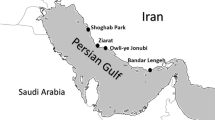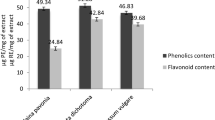Abstract
Aqueous extracts from 33 species of marine algae were assessed for their methyl mercaptan-trapping activity by gas chromatography to search for novel natural oral deodorants. Brown algae belonging to the Laminariales such as Eisenia bicyclis, Ecklonia cava and Ecklonia kurome were found to show remarkable deodorizing action against methyl mercaptan. The effective components in Eisenia bicyclis were identified as a phlorotannin, a group of molecules which are characteristic components of Laminariales. In addition phlorotannins extracted from E. bicyclis were more effective at reducing methyl mercaptan than conventional natural deodorants such as chlorophyll and sodium copper chlorophyllin.
Similar content being viewed by others
References
Alencastro RB, Sandorfy C (1972) A low tempertaure infrared study of self-association in thiols. Can. J. Chem. 50: 3594–3600.
Fujimoto K, Kaneda T (1980) Screening test for antioxygenic compounds from marine algae and fractionation from Eisenia bicyclis and Undaria pinnatifida. Bull. Jpn Soc. Sci. Fish. 46: 1125–1130.
Fujimoto K, Ohmura H, Kaneda T (1985) Screening for antioxygenic compounds in marine algae and bromophenols as effective principles in a red alga. Bull. Jpn. Soc. Fish. 51: 1139–1143.
Fukuyama Y, Miura I, Kinzyo Z, Mori H, Kido K, Nakayama Y, Takahashi M, Ochi M (1985) Eckols, novel phlorotannins with a dibenzo-p-dioxin skelton processing inhibitory effects on α2-macroglobulin from the brown alga Ecklonia kurome OKAMURA. Chem. Let. 1985 (6): 739–742.
Glombitza KW (1977) Highly hydroxylated phenols of the phaeophyceae. In: Faulkner DJ, Fenical WH (eds), Marine Natural Products Chemistry. Plenum Press, New York, 191–204.
Glombitza KW, Forster M, Eckhardt G (1978) Polyhydrophenyläther aus der Phaeophycee Sargassum muticum. Phytochemistry 17: 579–580.
Glombitza KW, Vogels HP (1985) Antibiotics from algae. XXXV. Phlorotannins from Ecklonia maxima. Planta Medica 51: 308–312.
Hoshino T, Matsumoto U, Goto T, Harada N (1982) Evidence for the self-association of anthocyanins. IV. PMR spectroscopic evidence for the vertical stacking of anthocyanin molecules. Tetrahedron Let. 23: 433–436.
Kaizu T (1976) Analysis of volatile sulfur compounds in mouth air by gas chromatography. Nippon Shisyubyo Gakkai Kaishi 18: 1–12 (in Japanese).
Kaji A (1976) Production methods of air-cleaners. Japan Patent 51-27882.
Kate M (1986) Techniques of Lipidology. Elsevier, Amsterdam, 112–185.
Krebs KG, Heusser D, Wimmer H (1969) Spray reagents. In: Stahl E. (ed.), Thin-Layer Chromatography. Springer-Verlag, Berlin, 854–909.
Kurata K (1979) Antibiotics from marine algae. In: Japan. Soc. Sci. Fish. (ed.), Biochemical Resources from Ocean. Koseisha-Koseikaku, Tokyo, 80–103.
Noguchi T (1979) Hemagglutinins and blood pressure reducing compounds. In: Japan. Soc. Sci. Fish. (ed.), Biochemical Resources from Ocean. Koseisha-Koseikaku, Tokyo, 137–151 (in Japanese).
Nomura T (1978a) Biologically Active Substances Produced by Marine Organisms. Nankodo, Tokyo, 149–160 (in Japanese).
Nomura T (1978b) Biologically Active Substances Produced by Marine Organisms. Nankodo, Tokyo, 160–165 (in Japanese).
Nomura T (1978c) Biologically Active Substances Produced by Marine Organisms. Nankodo, Tokyo, 167–169 (in Japanese).
Ochi M (1983) Antimicrobial substances. in: Japan. Soc. Sci. Fish. (ed.), Biochemistry and Utilization of Marine Alae. Koseisha-Koseikaku, Tokyo, 101–119 (in Japanese).
Sakagami Y (1983) Antiulcer substances. in: Japan. Soc. Sci. Fish. (ed.), Biochemistry and Utilization of Marine Algae. Koseisha-Koseikaku, Tokyo, 90–100 (in Japanese).
Sato Y, Terazawa M, Ishikawa H (1984) Deodorant gums containing green tea flavonoids. Shokuhinkogyo 27 (8): 42–48 (in Japanese).
Shiomi K (1983) Aggulutinins. In: Japan. Soc. Sci. Fish. (ed.), Biochemistry and Utilization Marine Algae. Koseisha-Koseikaku, Tokyo, 120–131 (in Japanese).
Somers BG, Gutowsky HS (1963) Nuclear magnetic resonance studies of hydrogen bonding in hindered phenols. J. Am. Chem. Soc. 85: 3065–3072.
Suzuki S, Moroe M, Uchida Y (1983) Green tea flavonoids. Shokuhinkogyo 26 (16): 57–65 (in Japanese).
Tanno H, Suzuki T, Meguro H, Esaki N, Tanaka H, Soda K (1985) Assay of L-methionine γ-lyase with N-(9-acridynyl)maleimide. Agric. Biol. Chem. 49: 1517–1518.
Tokita F, Ishikawa M, Shibuya K, Koshimizu M, Abe R (1984) Deodorizing activity of some plant extracts against methyl mercaptan. Nippon Nogeikagaku Kaishi 58: 585–589 (in Japanese).
Tonzetich J (1971) Direct gas chromatographic analysis of sulfur compounds in mouth air in man. Arch. Oral Biol. 16: 587–597.
Tonzetich J, Richter VJ (1964) Evaluation of volatile odoriferous components of saliva. Arch. Oral Biol. 9: 39–45.
Tsunoda M (1975) Analysis of fetor ex ore by gas chromatography. Nippon Shishubyo Gakkai Kaishi 17: 1–13 (in Japanese).
Tsunoda M, Sato H, Ohkushi T (1981) The experimental study for the effect of sodium copper chlorophyllin in halitosis. Nippon Shishubyo Gakkai Kaishi 23: 490–498 (in Japanese).
Author information
Authors and Affiliations
Additional information
Author for Correspondence
Rights and permissions
About this article
Cite this article
Kita, N., Fujimoto, K., Nakajima, I. et al. Screening test for deodorizing substances from marine algae and identification of phlorotannins as the effective ingredients in Eisenia bicyclis . J Appl Phycol 2, 155–162 (1990). https://doi.org/10.1007/BF00023377
Received:
Revised:
Accepted:
Issue Date:
DOI: https://doi.org/10.1007/BF00023377




